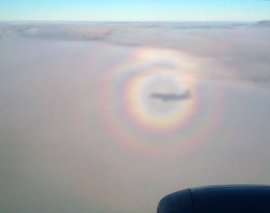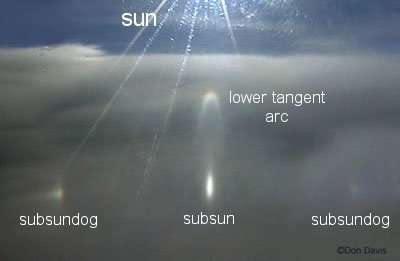Thanksgiving Skies

Thanksgiving is the biggest travel holiday of the year in the United States. Millions of people board airplanes and fly long hours to visit friends and family.
Do you dread the trip? Think of it as a sky watching opportunity. There are some things you can see only through the window of an airplane.
Image: A glory, photographed by air traveler Philip Laven. Copyright 2000, all rights reserved.
Atmospheric optics expert Les Cowley lists a few of his favorites:
"Both sides of the aircraft have their own sights," says Cowley. "On the side opposite the sun, the main thing to look for is the glory. Clouds below the aircraft are required. They are the canvas on which the glory is 'painted.''
"Look toward the antisolar point, the place in the clouds directly opposite the sun," he instructs. "There, if the aircraft is low enough, you will find the shadow of the plane. Surrounding the shadow is the glory--a bright white glow surrounded by one or more shimmering rings of color."
"These rings are formed when light is scattered backwards by individual water droplets in the cloud. The more uniform the size of the cloud droplets, the more rings you will see. They swell and contract as you travel over clouds with smaller or larger droplets."
No clouds beneath you?
"In that case," says Cowley, "another optical effect might be visible, especially over arid regions or pine forests. This is the opposition effect, a bright patch of light moving along the ground below you. The brightening, which is always directly opposite the sun, marks the point where the shadows of objects, like trees or soil granules, are hidden beneath those objects. The area consequently looks brighter, and slightly more yellow, than the surroundings." (Click here to view an image of the opposition effect, photographed by Eva Seidenfaden flying over Uzbekstan.)
Turning to the sunward side of the aircraft...
"That is the realm of ice halos," says Cowley. Ice halos are rings and arcs of light caused by ice crystals in high clouds. "They are often rainbow-colored," he notes, "but they are not rainbows."
From the ground you look up to see these halos. From an airplane you look down.
"You might be able to see subhorizon halos invisible from low ground," says Cowley. "The brightest, sometimes blindingly bright, is the subsun. This is a direct reflection of the sun from millions of flat plate-shaped ice crystals floating in the clouds beneath you and acting together as a giant mirror. As the aircraft moves the subsun drifts along the clouds, sometimes growing, sometimes contracting, sometimes wobbling as crystals with different tilts are sampled. Sometimes a column of light will extend upward from the subsun toward the real sun--this is a lower sun pillar."

Image: Subhorizon halos photographed by Don Davis. Copyright 2005, all rights reserved. Click on the image to view labels.
"Sunrise and sunset from high altitudes are special," Cowley adds. "The speed of the aircraft can make them faster or slower than usual. Furthermore, the sun is extra-flattened because its light is refracted almost twice the normal amount by its passage into the dense lower atmosphere and then out again to you. On a night flight, you might catch the moonrise; its distortions and flattening are greater for the same reason."
"And if none of these things are visible on your particular flight, ignore fellow passengers and crane your head to see some of the sky above you. It is dark and a deep violet blue--darker than you will ever see on the ground. A large part of Earth's atmosphere is beneath and there are far fewer molecules to scatter the sun's light and turn the sky blue. You are not far from space."
Happy Thanksgiving!
Source: Science@NASA, by Les Cowley & Dr. Tony Phillips















